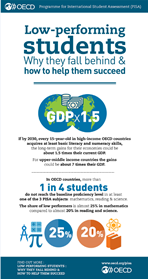Publications

Low-Performing Students
Why They Fall Behind and How To Help Them Succeed
There is no country or economy participating in PISA 2012 that can claim that all
of its 15-year-old students have achieved a baseline level of proficiency in mathematics,
reading and science. Poor performance at school has long-term consequences, both for
the individual and for society as a whole. Reducing the number of low-performing
students is not only a goal in its own right but also an effective way to improve
an education system’s overall performance – and equity, since low performers are disproportionately
from socio-economically disadvantaged families.
Low-performing Students: Why they Fall Behind and How to Help them Succeed examines
low performance at school by looking at low performers’ family background, education
career and attitudes towards school. The report also analyses the school practices
and educational policies that are more strongly associated with poor student performance.
Most important, the evidence provided in the report reveals what policy makers, educators,
parents and students themselves can do to tackle low performance and succeed in school.
Published on February 10, 2016
In series:PISAview more titles
TABLE OF CONTENTS
| Foreword | |
| Executive Summary | |
| Reader's Guide | |
| Who and Where are the Low-Performing Students? | |
| Student Background and Low Performance | |
| Engagement, Motivation and Self-Confidence among Low-Performing Students | |
| How School Characteristics are Related to Low Performance | |
| Policies Governing School Systems and Low Student Performance | |
| A Policy Framework for Tackling Low Student Performance | |
| List of tables available on line |
Powered by OECD iLibrary
